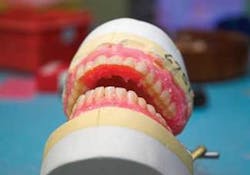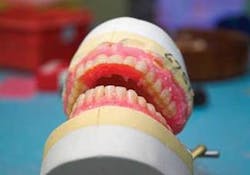Removable prosthodontics
Why discuss removable appliances? Because not all of our patients are eligible, clinically or financially, for full-mouth rehabilitation and implants.
Complete, immediate, and interim dentures
A complete denture is academically defined as a removable dental prosthesis that replaces all of the natural dentition and associated structures of the maxillae (upper) or mandible (lower).
An immediate denture is academically defined as a removable dental prosthesis constructed for placement immediately following the extraction of any remaining natural teeth. This classification of appliance is often associated with some type of intentional surgical intervention.
An interim denture is academically defined as a removable dental prosthesis that will not intentionally be relined or rebased. The classification of this appliance indicates a brief period of use by the patient.
Most dentures are traditionally constructed of lightweight acrylic resin. When a denture is metal-based, simply code for the denture itself and include a narrative description (by report) to describe the type of metal as well as the patient’s clinical indication for the specific technique. Unfortunately, most benefit plans provide reimbursement only for appliances constructed with accepted and conventional procedures and materials. The difference in fee is usually the patient’s responsibility.
Insurance reimbursement for complete maxillary and mandibular dentures is based on percentile or scheduled amounts as specified in the plan’s benefit provisions. The provider should exclude from the usual fee any individual characterizations that could be considered cosmetic or elective. The prosthesis is expected to be fabricated within the standards of professionally acceptable prosthetic care.
When addressing cosmetic or elective considerations, it is paramount to establish a usual fee for each denture, then separately (by percentage of appliance fee) add individual characterizations. The additional costs will rarely be a reimbursement liability in third-party contracts. However, some executive plans reimburse for all dental services rendered by a licensed dentist - so don’t sell yourself short by not listing the clinical enhancements in both the patient record and financial ledger.
With complete dentures, needed relines and adjustments are not charged separately to either the patient or benefit plan for the first six months following placement.
Immediate dentures are prosthetic appliances placed at the time of tooth extraction. These appliances replace all the teeth in a specific dental arch. Since surgical intervention is a classification criterion for immediate appliances, any necessary, time-consuming, chairside relines are traditionally charged separately following the first six months of placement. Hence, the slightly higher fee for the immediate vs. complete.
Interim complete dentures are rarely covered by any plan and must be paid for out-of-pocket by the patient.
Partial dentures
While dentures replace all the natural teeth in an arch, partial dentures replace one or more - but less than all - of the natural teeth and associated structures of the arch.
Of consideration with partial dentures is the fact that patients may request a single, multiple, or fixed (nonremovable) appliance in lieu of the traditionally benefited removable appliance. The fact remains that with most benefit plans, multiple missing teeth in both quadrants of a single arch will provide reimbursement for only a single removable appliance.
The treatment decision always rests with the patient and treating dentist, while the reimbursement criteria falls to the plan administrator. Do not be offended when the patient’s benefit plan only provides reimbursement for the less costly removable appliance. The patient is responsible to you and your office for the part of the fee not covered by the plan. Submitting claims for all treatments as they are completed is the best way to help patients get the most financial benefit from their plans. In other words, submit the claim for the service even if the patient’s annual maximum benefit amount has been reached.
Adjustments and repairs
During the course of a prosthetic’s lifetime, routine adjustments and repairs will be needed. Many patients neglect this and do not seek continuing care, just as some patients with natural teeth do not. Minor adjustments and repairs, performed at regular intervals, will prevent such long-term issues as ridge resorption, occlusion, and overall patient nutrition problems, as well as address esthetics and comfort. Hygiene coordinators should not overlook this critical segment of the patient base. Benefit plans routinely reimburse for two adjustments per benefit year beyond the first six months of initial placement.
Repairs to existing appliances can produce some challenging reimbursement issues. It is imperative that the clinical team specifies the nature and type of repair is due to either occlusal complications of natural attrition or an accident.
The simple replacement of worn-out teeth is often benefited to the patient only once per tooth per contract year, while some plans benefit replacement only once per three benefit years. This limitation does not apply to the replacement of broken teeth due to accident or injury. The benefit plan needs to know the nature of the accident and extent of the injury for reimbursement consideration.
Most plans exclude benefits for any type of repair or adjustment during the first six months following placement. The fee for any single repair should not exceed 50 percent of the fee for a new replacement appliance.
Rebases and relines
As with most removable appliances, rebases, relines, repairs and adjustments are not separately benefited for the first six months following initial placement. The exception to this is the interim appliance, which has no benefits for any type of enhancement or modification.
A rebase procedure replaces the entire substructure of the appliance, with the exception of any cast framework or teeth, without changing the occlusal relationship or vertical dimension. This procedure often takes place following a series of successful relines where the appliance substructure is simply duplicated or “jumped.” The existing teeth and occlusal dynamics are not modified with a rebase procedure.
Relines modify the occlusal dynamics by adding to and changing the substructure of the appliance. This resurfacing of the basal surface is intended to increase the accuracy of how the appliances fit against the tissue. Not unlike adjustments and repairs, many plans address the reimbursement of reline procedures twice per benefit period.
Precision attachments
This procedure in the D5800 series is identified if the final appliance is to be removable by the patient. This type of attachment is most often used in the delivery of complete and/or partial overdenture appliances, as well as traditional partial dentures that do not replace all the teeth in an arch.
Submit a description of the final appliance, materials used, type of attachment, and an explanation of the attachment’s necessity. Always identify which teeth are being replaced as well as any dates of extraction. Now comes the fun part - explaining why a conventional appliance will not be satisfactory!
Focus the discussion on both the mechanical and masticatory considerations. Discuss bone resorption, compromised ridge(s), and/or crown/root ratio of abutments, and periodontal- and endodontic-compromising conditions, along with their associated forces of occlusion. Don’t forget to identify what type of dentition, if any, the final appliance will be occluding against. In the absence of a narrative report, benefits for this procedure are most often denied as simply a cosmetic exclusion. But remember, the poor morphology of a “cone-shaped” abutment is unsatisfactory for clasp retention.
Overdentures, complete and partial
Whether they are complete or partial, overdentures are patient-removable appliances that are retained not only by tissue, but also by nonvital, retained tooth roots with copings or dental implants. These buttresses provide additional improved support and stability while reducing ridge resorption.
The additional costs of the completed overdenture technique include, but are not limited to, the semi-precision attachments, endodontic therapy (billed separately) and cast copings (billed separately), as well as any customized or prefabricated implant abutments.
In today’s competitive world of benefit-plan design and administration, more purchasers are opting for additional benefits to better serve the needs of their aging workforce. In the past, it was not uncommon for a plan administrator to simply reimburse for the cost of overdenture appliances with the alternate benefit of a traditional nonsupported denture or partial. When a plan administrator increases its reimbursement for the traditional denture by 7 percent to 10 percent, that is at least a step in the right direction toward helping the patient offset the 60 to 70 percent increase in the doctor’s fee for the overdenture technique.
Can additional implant benefits be far behind?Tom Limoli Jr. is the president of Atlanta Dental Consultants and the editor of “Dental Insurance Today,” a bimonthly publication that addresses third-party reimbursement in the dental office. He also is the author of “Dental Insurance and Reimbursement Coding and Claim Submission.” He can be contacted by phone at (404) 252-7808. Visit his Web site at www.LIMOLI.com.

